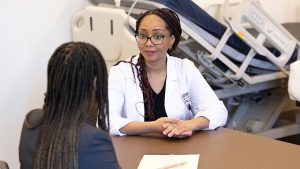
Socioeconomically disadvantaged neighborhoods have fewer home hospice agencies, study shows.
The number of Medicare beneficiaries receiving home hospice care has more than doubled since 2000. With the American population aging at a historically unrivaled rate, that number only stands to increase in the years to come. Yet hospice care in the United States is not distributed or accessed equally. Around half of all patients with severe illnesses—many concentrated in underserved neighborhoods—do not use hospice services.
“We know that poorer neighborhoods have continued to lag behind in utilization of hospice care. For decades, scientists have attributed it to cultural values or preferences about care,” said Zainab Toteh Osakwe ’06, PhD, associate professor in the Adelphi University College of Nursing and Public Health and an expert in home healthcare. “We also tend to think of hospice care as something that’s delivered only in the field, not related to the hospice agency’s home base. But after COVID, I started to wonder if where the hospice offices are located has an impact on the delivery of care.”
Dr. Osakwe partnered with a geospatial analyst at the University of North Dakota to uncover patterns in the locations of hospice offices. Drawing on information made publicly available by the Centers for Medicare and Medicaid Services, they culled data related to 3,447 hospice providers and 4,584 Medicare-certified hospices nationwide. Next, they geocoded hospice agency addresses to the social vulnerability index (SVI), a measure developed by the Centers for Disease Control and Prevention that geographically ranks at-risk communities.
The resulting study, with co-authors including Jennifer McIntosh, PhD ’21, adjunct professor of public health, and undergraduate student Kaydeen Pierre, was published as “Association of Hospice Agency Location and Neighborhood Socioeconomic Disadvantage in the U.S.” (American Journal of Hospice and Palliative Medicine, 2023),1 funded in part by the Claude D. Pepper Older Americans Independence Center (OAIC) at the Icahn School of Medicine at Mount Sinai. The article highlights the association between hospice agency location and neighborhood social vulnerability.
Dr. Osakwe and her team found that hospice agency offices were far more likely to be clustered in neighborhoods with greater socioeconomic advantage. Predominantly Black and Hispanic neighborhoods also contained significantly fewer hospice agency offices. While the results align with prior studies on hospice supply and community-level wealth, theirs is one of the first to investigate hospice agency availability by neighborhood. This finding is important as policymakers and researchers invest in enhancing community awareness of hospice, particularly in socioeconomically disadvantaged neighborhoods. According to the authors, the study “expands the existing body of research by addressing social vulnerability … and provides new evidence that greater neighborhood socioeconomic disadvantage is independently associated with lower availability of hospice agencies at the census tract level.”
However, this work is “not reflective of utilization,” Dr. Osakwe noted. “It doesn’t tell us that these neighborhoods received less care. What it does tell us is that disparities in access may also stem from a lack of awareness, as well as a limited presence of hospice agencies in neighborhoods with greater disadvantage.” When a service is located within a community, members of that community will inevitably engage with it. “If the central office of Home Depot is built in my neighborhood, for instance, my neighbors will be working for, relating to Home Depot employees and shopping at Home Depot. Similar principles may be at play with hospice care.”
For communities that fail to use—or perhaps even fear—hospice care, Dr. Osakwe’s work can begin to make up the difference. “We know that presence bolsters community awareness, so the more hospice offices we can set up in disadvantaged neighborhoods, the more likely those communities are to better understand hospice care, which remains a largely misunderstood Medicare benefit.” As state governments and federal programs like Medicare/ Medicaid invest more time and funds into healthcare equity, this outreach has never been more critical. “Neighborhood socioeconomic disadvantage is an independent factor that potentially contributes to disparities in hospice availability in the U.S.,” the paper explains. “Policymakers should be aware of these associations and take steps to mitigate disparities in access to hospice at the neighborhood level.”
According to Dr. Osakwe, it’s an effort that requires participation across the board—not just from policymakers and government agencies, but from the entire community. “Once agencies exist in more disadvantaged communities, they can begin to serve as real business partners, which will send out a strong message to community members as well as local clinicians. That will move the needle forward.”
Biography
Zainab Toteh Osakwe ’06, PhD

Zainab Toteh Osakwe ’06, PhD
Zainab Toteh Osakwe ’06, PhD, is an associate professor in the College of Nursing and Public Health. Her research focuses on the quality and disparities of care received by homebound adults, as well as nurse practitioner home-based primary care and dementia care, with a goal of developing interventions and informing policies that expand access to home-based care. Dr. Osakwe is a 2022 Health Care Systems Scholars Program grant awardee from the National Institute on Aging IMPACT Collaboratory.
Jennifer McIntosh, PhD ’21,

Jennifer McIntosh, PhD ’21
Jennifer McIntosh, PhD ’21, is an adjunct professor in the College of Nursing and Public Health as well as a lecturer at Yale School of Nursing. A former emergency nurse, Dr. McIntosh’s recent research has focused on emergency nurses’ perceptions of attribution and individualized care toward people with mental illness and on “VIP care”: providing enhanced care to people deemed more important than others, and the clinical and ethical implications of that for nurses and care recipients.
¹Osakwe, Z. T., Calixte, R., Peterson, M.-L., Young, S. G., Ikhapoh, I., Pierre, K., … Girardin, J.-L. (2023). Association of Hospice Agency Location and Neighborhood Socioeconomic Disadvantage in the U.S. American Journal of Hospice and Palliative Medicine®, 41(3), 309–317. doi:10.1177/10499091231195319